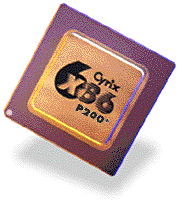CPU Guide
Introduction
If you expect top performance from your system, you have to accept that it all starts and ends with the CPU. Whiz-bang graphics cards and oceans of RAM won't fix a system that's dragged down by a pokey processor. Wether you'ew crunching numbers or rendering dimly lit hallways in Quake, the capability of your system to get the job done relies first and foremost on its CPU.
AMD K5

The AMD K5 has been coming slowly, but now it's there and getting better and better. By now, you can get it from a PR 75 up to a PR 166. It's FPU is still slower than the FPU of the Pentium, but it's better than the FPU of the 6x86. It also will soon be released as a split voltage version, which will reduce heat problems of this CPU as well.
Here a table to show the weird CPU speed/bus speed/multiplier relations of the K5 CPUs:
| Processor Performance | Clock Speed(MHz) | Bus Speed(MHz) | PCI Bus Speed(MHz) | Multiplier |
| K5 PR75 | 75 | 50 | 25 | 1.5 |
| K5 PR 90 | 90 | 60 | 30 | 1.5 |
| K5 PR 100 | 100 | 66 | 33 | 1.5 |
| K5 PR 120 | 90 | 60 | 30 | 1.5 |
| K5 PR133 | 100 | 66 | 33 | 1.5 |
| K5 PR 166 | 116.66 | 66 | 33 | 1.75 |
As you can see, the PR120 runs at the same speed as the PR90, the PR100 runs at the same speed as the PR133. These CPUs obviously have got a different die. The PR120 and PR133 are more advanced than the PR90/100. This however only touches the integer performance. The FPU performance of the PR133 is the same as of the PR100.
Due to these strange multiplier settings, the K5 has got a fixed multiplier, which cannot be changed from out side via multiplier jumpers. The PR75 to PR133 will run at 1.5 multiplier regardless what the jumpers say, the PR166 will also always run at x1.75.
The Cyrix 6x86


The Cyrix 6x86 or M1, as it was called before, is a strong contender to the Intel Pentium and is able to outclass the Pentium in quite a few respects. This CPU might also be able to push technology forward more than the current Pentium CPUs, because since the 6x86 P200+ was released, a new bus speed of 75 MHz turned up at the horizon to replace the old maximum of 66 MHz of Intel CPUs. This will require new memory technology as well as new chipsets and therefore new motherboards.
This however is also the downside of the new 6x86 P200+, because you can't run this chip in a Triton FX or HX board for they don't support a bus speed of 75 MHz. Only to remind you - the 6x86 P200+ runs at a clock speed of 150 MHz, which is a multiplying of the 75 MHz bus speed with 2. Would you run this CPU with a bus speed of only 50 MHz and a multiplier of 3, you would loose all the speed advantages due to this pathetic slow bus speed.
Stay on the Cutting Edge
Join the experts who read Tom's Hardware for the inside track on enthusiast PC tech news — and have for over 25 years. We'll send breaking news and in-depth reviews of CPUs, GPUs, AI, maker hardware and more straight to your inbox.
Technical Specifications of the 6x86
| Processor Performance | Clock Speed(MHz) | Bus Speed(MHz) | PCI Bus Speed(MHz) | Multiplier | Special |
| 6x86-P200+ | 150 | 75 | 37.5 or 33 | 2 | needs specialmotherboard and chipset to support75 MHz bus speed ! |
| 6x86-P166+ | 133 | 66 | 33 | 2 | no |
| 6x86-P150+ | 120 | 60 | 30 | 2 | no |
| 6x86-P133+ | 110 | 55 | 27.5 | 2 | needs motherboard thatsupports 55 MHz bus speed |
| 6x86-P120+ | 100 | 50 | 25 | 2 | no |
- Clocking 2x, 3x bus-to-core clock multiplier, no 1.5 or 2.5 clock multiplier !
- L1 Cache 16 kByte; write-back; 4-way associative; unified insTRuction and data; dual-port address
- Bus 64 bit external data bus; 32 bit address bus
- Pin/Socket P54C socket compatible (296-pin PGA)
- Compatibility Fully compatible with x86 operating systems and software including Windows 95, Windows, Windows NT, OS/2, DOS, Solaris and UNIX
- Floating Point Unit 80 bit with 64 bit interface; parallel execution; uses x87 insTRuction set; IEEE-754 compatible
- Voltage 3.3V core with 5V I/O tolerance
- Power Management System Management Mode (SMM); hardware suspend; FPU auto-idle
- Multiprocessing Supports SLiC/MP and OpenPIC interrupt architecture
- Burst Order 1-plus-4 or linear burst
Most Popular

